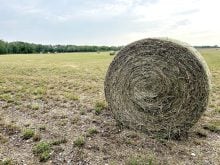Private landowners in Peace region municipalities are receiving less help from the province in the battle against the mountain pine beetle.
The tree-destroying pest had a high winter survival rate in the Grande Prairie region relative to other parts of Alberta but the province has “backed right off” in funding for removal of infected trees.
“The priorities have changed as far as who’s getting money,” said Devin Letourneau, the local forest health officer with the Ministry of Sustainable Resource Development.
Read Also

Hail research hopes to benefit potato growers
Alberta research scientist measures hail storm and heat dome affects on potato crops
“In the beginning, the Grande Prairie area received the lion’s share. This year, due to the large beetle in-flight last year, the priority is on the leading edge which is near Whitecourt, Slave Lake and Fox Creek.”
Past provincial funding has made a difference, with some inroads made in the battle against the pine beetle, said Jerry Bauer, the County of Grande Prairie’s mountain pine beetle co-ordinator. The province’s Municipal Grant Program has funnelled more than $20 million since in inception in 2006 into the Peace region via the South Peace Municipalities consortium (comprised of the county and city of Grande Prairie, the municipal districts of Greenview and Spirit River and the counties of Saddle Hills and Birch Hills).
By the winter of 2006-07, all private land between the Wapiti and north to Peace River spanning five municipalities was surveyed for beetles.
“We worked with landowners to remove trees and destroy beetles at no cost to the landowner,” said Bauer. “I think the first winter we spent close to $9 million.”
There was a huge learning curve at the outset, said Bauer.
“Lots of landowners wanted to deal with the problem on their own, and if the trees were still green they didn’t want anyone to take them down.”
Still, about 100,000 trees were removed that first year.
Similar funding dollars were available in the second year, but work was concentrated south of Saddle Hills County, around Grande Prairie, west to Beaverlodge and east to Valleyview. Funding in the third year of program funding was similar, but the geographic area shrunk even further, and work was concentrated along the Wapiti River Corridor and highly valued recreational lands around the Dunes area, as well as rural subdivisions south of Grande Prairie and near Wembley.
South Peace Municipalities received a commercial timber permit, and salvaged trees were sold to the Canfor and Weyerhaeuser mills near Grande Prairie.
“We managed to sell $1 million worth of timber over the first three years,” said Bauer. These dollars were injected back into the beetle-control program.
“In the fourth year, the province backed right off our funding was significantly less and there was none for work on private land,” said Bauer.
Focus of activities switched from beetle control to Firesmart work. The private land program ended last year and the South Peace Municipalities group is no longer in operation.
Last summer’s major beetle in-flight from B. C. was discouraging, said Bauer.
“A lot of the work we did was negated,” said Bauer. “We were getting lots of calls from people who had had their windbreaks totally infested and we had no dollars to help.”
It’s costly to remove beetle-killed trees about $200 per tree and that’s a big reason why landowners are not doing much to counter the infestation, said Dan Jobson, who runs a tree-removal service out of his home base in Beaverlodge, one of the local hot spots for beetle infestation.
“Lots of people seem to be just avoiding it if you drive around the countryside you see huge stands of beetle-killed trees,” said Jobson. “We’ve done the odd private job and have a few more on tap, but there’s not been much interest from private landowners.”
For those landowners who do remove trees, Tree Canada’s ReLeaf program (partly funded by Sustainable Resource Development) provides an $80 coupon for tree replacement, which can be redeemed at any greenhouse that is a member of the Landscape Alberta Nursery Trades Association. Acreage owners who have lost several trees can receive up to $3,000 for shelter-belts, and municipalities can also submit applications for up to $5,000 for tree replacement. The deadline is December 31.
Letourneau said the Municipal Grant Program is being funded again, though dollars are reduced this year.
“The funding has lessened every year since its inception as the beetle populations progress eastward across the province,” he said.
But while beetle populations are moving eastward, taking the bulk of provincial funding with them, the fight goes on in the Peace region.
“We’ll never eradicate this from the landscape,” said Bauer. “But we can try to control it, reduce it, mitigate its impact, and hope for a cold winter so the beetles will drop off naturally.”
———
“Lotsofpeopleseemto bejustavoidingit–if youdrivearoundthe countrysideyouseehuge standsofbeetle-killed trees.”
DAN JOBSON
FITS IN A COUPLE OF LINES ATTRIBUTION FITS BUSINESS














